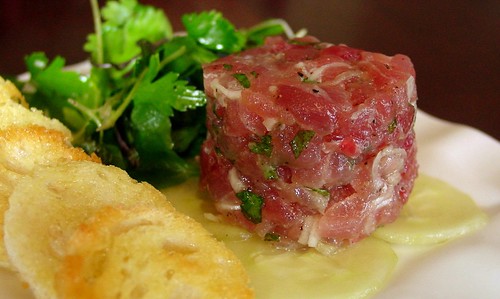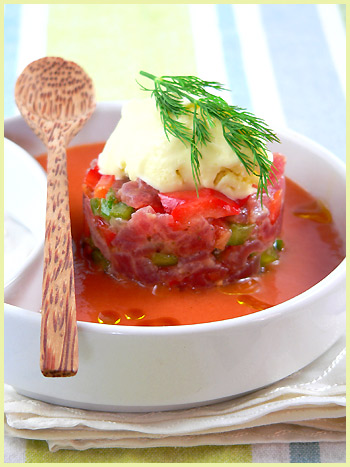I, for one, have never eaten it, nor have I seen it in person.

An example of what tuna tartare can look like.
(Image from Flickr, sourced from My Life as a Reluctant Housewife)
I am compelled to ask, what is "tartare" anyway?
(By the way, I'm back from my trip. It was restful. There was pie and there was football. It was good.)
Various experts disagree about what tartare is exactly.
- Some people say it's raw steak, some say raw beef, others say raw fish.
- Some people say the protein has to be mixed with raw egg yolk plus spices.
- Others say it only has to be chopped or minced.
- Still others say that not only must it be raw, chopped, and mixed with egg yolk, it also has to be shaped into little cakes.
So, obviously, I had to look a little deeper. I did and I thought I had found the real story, which follows:
- Tartare was first made from beef (or perhaps horsemeat). Way back in the Medieval times, the nomadic Mongolian and Turkish tribes needed to eat on the go. The meat they ate came from the wily Asian cattle that they herded, and the meat was usually tough. To make it more palatable, they stuck it under their saddles while they rode to tenderize it, and then they shredded it.

The Mongols, a.k.a Tartars, on horseback
Image from A Thousand Years of the Tartars, by E.H. Parker
- When Europeans got introduced to this dish, they thought it was rather beneath them (no pun intended). They referred to the tribes who ate it as Tartars, meaning that they might as well be denizens of the Grecian mythological hell Tartarus. Though the Europeans didn't think much of these people, the Germans started preparing the dish and serving it to each other -- referring to it as a dish of the Tartars.
- Over time, the Germans and the French started changing the way the dish was prepared. They added eggs, they added spices, they shaped it into little cakes to make it pretty. In other words, they gave it cachet.
- Now it's served in very highbrow restaurants, and you are considered a very knowledgeable diner with a sophisticated palate if you enjoy tartare.

Steak tartare, with a quail's egg on top, served by the "trendy little bar" in the Museum of Modern Art in NY City
(Photo from We Eat Everything)
But then on digging still further, I found out that whole story about the Mongol tribes/Tartars is a big fat lie.
- There were actually Mongol tribes, and they did put slabs of meat between their saddles and the horse's back, but they did it as a way to treat the horse's saddle sores, in much the same way Western folks used to put a beefsteak on a black eye. The Mongols never ate that saddle meat.
- Also, nobody can say for certain that the steak tartare dish actually made the journey from the steppes into Germany, then into France, then to the United States. People who do their homework more assiduously have to shrug their shoulders and say, "We're not sure where it came from."
- There is some veiled suggestion that perhaps the dish came into popularity in times of economic distress (big wars) when people had little else to eat besides horseflesh, and they ate it raw. Then the dish would fade from popularity when times got good again. But I can't substantiate this suggestion at all.
- While various reputable sources cite the first documented appearance of steak tartare sometime around 1911, most say that the dish did not really become popular until post-World War II. The Rat Pack era, presumably.
- There is also some debate about whether French restaurants consider the dish an American creation, or if filet americain is another dish entirely than steak tartare.

At this top restaurant, Harris' steakhouse in San Francisco (note the odd fresco behind this table), an appetizer of steak tartare will set you back $12. A steal, compared to the Kobe ribeye, which goes for a princely $75.
(Photo from Top Restaurants)
Regardless of its mysterious history, tuna tartare is raw fish, chopped up or sometimes only sliced. Put in it what you think would taste good. And, contrary to my hopes, the act of chopping or slicing does nothing to reduce the possibility that eating the raw fish might get you sick.

This tuna tartare is topped with wasabi ice cream.
(Photo & recipe from La Tartine Gourmande)
Sources
The Straight Dope, What do steak tartare, tartar sauce, and dental tartar have in common?
Food Timeline, history notes, steak tartare
This Wild Ride, The Raw History of Steak Tartare
At Home with Patricia Wells, Paris Cookbook, tartare
Compact Oxford English Dictionary, tartare
BBC Food Glossary, tartare
Dictionary.com, tartare
Ultralingua Online Dictionary, tartare
Cambridge Advanced Learner's Dictionary, tartare
Infoplease dictionary, tartare
Hi Apple Lady,
ReplyDeleteWhat great research you do and what a lovely writing style you have, and so succinct too.
Your mention of le filet americain reminds me of the time I ordered it in a Brussels restaurant, thinking to try something new. My colleagues' meals all arrived first, looking and smelling delicious. Then mine arrived - not at all what I was expecting. Raw, cold and with the raw egg you mention on the top. I still cringe with embarrassment when I remember having to ask them to cook it for me. They wouldn't, of course, but did replace it with something else.
Bye for now,
John (aka DaftNotStupid)
Hi John,
ReplyDeleteThanks for the comment -- and the compliment. Knowing what I know now, I don't think I would ever order anything tartare. But I might have tried it once upon a time, just to be adventurous.
Hey everybody! John (DaftNotStupid) and I are site neighbors (siteneighbors.com). Though I should note that while the Daily Apple is a neighbor of his site, his site is not a neighbor of mine. Why that is, I have no idea; the workings of the whole Site Neighbors thing is still inscrutable to me.
Nonetheless, if you're at all interested in world music check out his blog: daftnotstupid.blogspot.com.
I greatly enjoy "kitfo", an ethopian dish similar to steak tartare. Since I'm not ethiopian, they always offer to cook it. I usually ask them to cook it slightly, so it's not really cooked but not totally raw either.
ReplyDeleteSo would that be akin to really rare steak? When you order steak, is that how you like it cooked?
ReplyDelete(and I couldn't resist, I had to look up kitfo: http://www.ethiopianrestaurant.com/dishes/kitfo.html )
Fascinating. Thanks for doing this research I feel so informed! =)
ReplyDelete